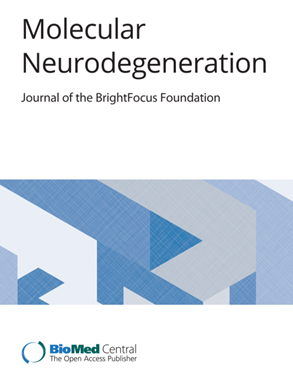Heparin-enriched plasma proteome is significantly altered in Alzheimer’s disease
IF 14.9
1区 医学
Q1 NEUROSCIENCES
引用次数: 0
Abstract
Heparin binding proteins (HBPs) with roles in extracellular matrix assembly are strongly correlated to β-amyloid (Aβ) and tau pathology in Alzheimer’s disease (AD) brain and cerebrospinal fluid (CSF). However, it remains challenging to detect these proteins in plasma using standard mass spectrometry-based proteomic approaches. We employed heparin-affinity chromatography, followed by off-line fractionation and tandem mass tag mass spectrometry (TMT-MS), to enrich HBPs from plasma obtained from AD (n = 62) and control (n = 47) samples. These profiles were then correlated to Aβ, tau and phosphorylated tau (pTau) CSF biomarkers and plasma pTau181 from the same individuals, as well as a consensus brain proteome network to assess the overlap with AD brain pathophysiology. Heparin enrichment from plasma was highly reproducible, enriched well-known HBPs like APOE and thrombin, and depleted high-abundant proteins such as albumin. A total of 2865 proteins, spanning 10 orders of magnitude in abundance, were measured across 109 samples. Compared to the consensus AD brain protein co-expression network, we observed that specific plasma proteins exhibited consistent direction of change in both brain and plasma, whereas others displayed divergent changes, highlighting the complex interplay between the two compartments. Elevated proteins in AD plasma, when compared to controls, included members of the matrisome module in brain that accumulate with Aβ deposits, such as SMOC1, SMOC2, SPON1, MDK, OLFML3, FRZB, GPNMB, and the APOE4 proteoform. Additionally, heparin-enriched proteins in plasma demonstrated significant correlations with conventional AD CSF biomarkers, including Aβ, total tau, pTau, and plasma pTau181. A panel of five plasma proteins classified AD from control individuals with an area under the curve (AUC) of 0.85. When combined with plasma pTau181, the panel significantly improved the classification performance of pTau181 alone, increasing the AUC from 0.93 to 0.98. This suggests that the heparin-enriched plasma proteome captures additional variance in cognitive dementia beyond what is explained by pTau181. These findings support the utility of a heparin-affinity approach coupled with TMT-MS for enriching amyloid-associated proteins, as well as a wide spectrum of plasma biomarkers that reflect pathological changes in the AD brain.富含肝素的血浆蛋白质组在阿尔茨海默病中发生显著变化
在细胞外基质组装中发挥作用的肝素结合蛋白(HBPs)与阿尔茨海默病(AD)大脑和脑脊液(CSF)中的β-淀粉样蛋白(Aβ)和tau病理学密切相关。然而,使用基于标准质谱的蛋白质组学方法检测血浆中的这些蛋白质仍然具有挑战性。我们采用肝素亲和层析法,然后进行离线分馏和串联质量标记质谱(TMT-MS),从AD(n = 62)和对照组(n = 47)样本的血浆中富集了HBPs。然后将这些图谱与Aβ、tau和磷酸化tau(pTau)CSF生物标记物、来自相同个体的血浆pTau181以及共识脑蛋白质组网络相关联,以评估与AD脑病理生理学的重叠。从血浆中富集肝素的重现性很高,富集了APOE和凝血酶等众所周知的HBPs,去除了白蛋白等高丰度蛋白质。在109个样本中共测定了2865种蛋白质,丰度跨度达10个数量级。与共识的AD大脑蛋白共表达网络相比,我们观察到特定的血浆蛋白在大脑和血浆中表现出一致的变化方向,而其他蛋白则表现出不同的变化,这突显了两个区室之间复杂的相互作用。与对照组相比,AD血浆中升高的蛋白质包括脑中随Aβ沉积而聚集的基质组模块成员,如SMOC1、SMOC2、SPON1、MDK、OLFML3、FRZB、GPNMB和APOE4蛋白形式。此外,血浆中的肝素富集蛋白与传统的 AD CSF 生物标记物(包括 Aβ、总 tau、pTau 和血浆 pTau181)有显著的相关性。五种血浆蛋白的曲线下面积(AUC)为 0.85,可将注意力缺失症患者与对照组患者区分开来。当与血浆 pTau181 蛋白结合使用时,该小组显著提高了 pTau181 蛋白单独使用时的分类性能,将 AUC 从 0.93 提高到 0.98。这表明肝素富集血浆蛋白质组捕捉到了 pTau181 无法解释的认知性痴呆的额外变异。这些发现支持了肝素亲和法与 TMT-MS 结合用于富集淀粉样蛋白相关蛋白以及反映 AD 大脑病理变化的多种血浆生物标记物的实用性。
本文章由计算机程序翻译,如有差异,请以英文原文为准。
求助全文
约1分钟内获得全文
求助全文
来源期刊

Molecular Neurodegeneration
医学-神经科学
CiteScore
23.00
自引率
4.60%
发文量
78
审稿时长
6-12 weeks
期刊介绍:
Molecular Neurodegeneration, an open-access, peer-reviewed journal, comprehensively covers neurodegeneration research at the molecular and cellular levels.
Neurodegenerative diseases, such as Alzheimer's, Parkinson's, Huntington's, and prion diseases, fall under its purview. These disorders, often linked to advanced aging and characterized by varying degrees of dementia, pose a significant public health concern with the growing aging population. Recent strides in understanding the molecular and cellular mechanisms of these neurodegenerative disorders offer valuable insights into their pathogenesis.
 求助内容:
求助内容: 应助结果提醒方式:
应助结果提醒方式:


